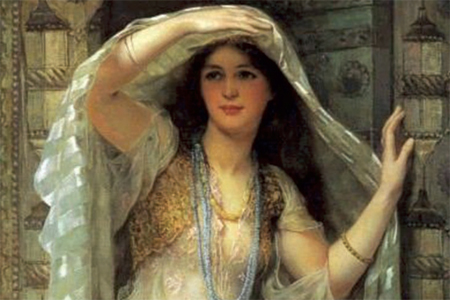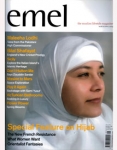
Unveiling Imperial Conquest
Issue 4 Mar / Apr 2004
The decision by the French government to outlaw religious dress and symbols in state schools has largely focused on the issue of the unveiling of Muslim girls. But does this aggressive secular imposition represent a new form of cultural imperialism aimed at the conquest of Islam and Muslim culture in Europe?
Mohammad Siddique Seddon offers an interesting historical contextualisation..
The Renaissance period was a time of great exploration and self-discovery for North- European civilisation. It was precipitated by a religious revolution that cast off the shackles of a repressive theocratic empire. The burgeoning nation-states, shaped by a new political autonomy and religious reformation, reached out beyond the confines of Christendom.
But the ‘Age of Discovery’ not only presented new freedoms, it also provided new opportunities in colonising and empire building. In the popular Elizabethan imagination the ‘New World’ was metaphorically represented in the female form as a wanton virgin waiting to be taken. This concept was visualised in Jan van der Straet’s depiction of Amergio Vespucci, clutching the cross whilst casting a gleeful eye upon on the languid, nude native- American girl in his painting simply titled America. Civilising and Christianising the naked Indian heathen was presented as a theological justification for colonial conquest. The de-indianised Pocahontas, one of the few indigenous Americans to visit Britain, was presented as a civilised, western-dressed Christian woman. The sad and displaced figure of Pocahontas perhaps best symbolises the imperial aspirations for the Europeanisation of the Americas.
At the same time, the process of demonising and racialising native Indians, through othering and difference, was transposed on to Islam and Muslims. Inter-changeable definitions and transferable stereotypes of both American Indians and Muslims provided a monolithic, yet seemingly plausible, demonic and barbaric other. However, historical and civilisational links between Europeans and Muslims meant the later could not be viewed as ‘primitive’ in comparison with the newly discovered American peoples. Furthermore, the determining difference between the two was that Muslims could not be conquered as the Indians could.
Therefore, the impenetrable Islamic world could also not be visualised as an open-armed ‘noble savage’, naked and gullible, waiting to be taken by a white knight. Conversely, the unconquerable Muslim lands where equated with the mysterious, closely guarded occupants of the harems, hidden away like priceless jewels. Unlocking the Muslim world (and the harem) could not be achieved by brute force alone as it had in the Americas. Hence, the unobtainable Orient, like the women of the harems, captured the imagination of Europe and quickly transmuted into an unhealthy fetish. Fascinations with Islam and Muslims - developed over centuries - were often portrayed through erroneous exotic travelogues, contemporary plays and popular novels. William Beckford’s History of the Caliph Vathek and Dantes Inferno are examples from many that sensualised and demonised Muslim civilization and theology.
But it was the visual representation in western art that conveyed the most vivid and imaginative ‘insights’ into the harem/Muslim world. As the interaction between West and East increased the resultant familiarity was not generally reflected in literary or pictorial representations. Instead, popular imagery of the Orient conformed to the political realities of economic and military tensions. The struggle against Ottoman forces became a recurring theme for western painters of the Orient. For example, Jacopo Robusti’s The Abduction of Helen (c.1580), not only alludes to the pirate raids on European soil by North African Corsairs, it symbolizes the capture of Eastern Europe, portrayed in the painting as a helpless maiden, by Ottoman Muslims.
The intriguing and mystical appeal of the East produced the most prolific and dramatic representations. Panthe Led Before Cyrus (c.1633), by Laurant de la Hyre depicts a beautiful unveiled and half naked Grecian Queen being presented to her Persian conqueror, her jewels and treasures strewn at her feet. As ancient Biblical narratives became a major source of inspiration in renaissance iconography, Protestantism established a religious conservatism that, whilst facilitating theological liberalism, imposed strict moral sobriety and sexual repression. However, unveiling the ‘barbaric’ Muslim other through erotic representation was an acceptable ‘license to thrill’ that further exoticised the Orient. By the eighteenth century, Lady Montagu, the wife of the English Ambassador, Wortley Montagu, was able to offer ‘revealing’ accounts of the lives of Muslim women through her collected letters written during her travels in the Ottoman Empire. Via fantastic tales of fiction, One Thousand and One Nights etc. and fanciful travelogues the Muslim world was captured – albeit only in the European imagination.
If the previous centuries had paved the way for a tempestuous obsession with the Orient, Orientalism, as an ideological tool of imperialism and colonial conquest, was perhaps at its intellectual zenith during the French and British territorial expansionism of the nineteenth century. The development of Orientalism as an essentialising hegemonic misrepresentation of the East by the West has been eruditely explored by scholars like the late Edward Said, Rana Kabbani and Ziauddin Sardar. In practical terms, the physical conquest of the Muslim world eventually witnessed the advent of modern secular liberalism as a direct imposition of Western hegemony. The mass unveiling of Muslim women spearheaded by the middle-class Western educated elite heralded the symbolic conquest of Islam and Muslims.
Further, the internalisation of Western feminism, particularly rooted in Christian theology and misogyny, by secular Arab intellectuals like Nawal al Saadawi in The Hidden Face of Eve and Fatima Mernissi in The Harem Within, has offered a misplaced encouragement for the de-islamisation project of the Muslim world. An unveiled Muslim woman has erroneously been interpreted as a ‘secular, liberal, enlightened and liberated’ woman. This simplistic and superficial interpretation is purely aspirational and merely reflects the Western European preoccupation with conquering the perpetuated Muslim other.
At a popular level, the European fetish for the Orient repeats the same motifs of conquest and domination. In Carry on up the Khyber, a bawdy British ‘comedy-film classic’, conquest is realised when the ‘Eastern Princess’ (played by an English actress) is freed from the harem, unveiled and then ‘westernised’ by the Colonial British Officer-hero. The narrative is as obvious and explicit as the Fry’s Turkish Delight television advertisement where the chocolate bar is the fetishised ‘object of desire’ and its purchase, unwrapping and consumption become an experiential conquest ‘full of Eastern Promise’.
The reactionary French unveiling of its Muslim women by brute (legal) force is a desperate and draconian means of imposing a rigid monoculture that is completely at odds with the current climate of European religious and cultural pluralism. Further, this form of cultural fascism strikes a deathblow to secular liberalism which values freedom of individual expression, religious tolerance and the right to cultural selfidentity. What the French government’s proposal is not, is the ‘liberation’ of Muslim women by the enforced assimilation of Muslims into a very restrictive French monoculture. Nor should this retrogressive politic be allowed to become the secular conqueste of Islam in Europe.
Mohammad Siddique Seddon is a Research Fellow at the Islamic Foundation in the Muslims in Britain Unit and is currently undertaking his PhD in Religious Studies at the University of Lancaster. He has published a number of works relating to Islam in Britain.
Sexual images of Muslim women are reflections of the Western male desire for Arab women whose bodies are thought of as exotic. Such sexual images of Arab women are often portrayed in Hollywood movies where Arab women are "victims" of Western male sexuality. In a capitalist society that has connection with white male domination, women's bodies are often used as commodities of men in the media. As Edward Said has stressed, an orientalist is a "racist," an "imperialist," and "ethnocentric." The veil has been a convenient material for orientalists to describe women in Muslim societies in comparison with women in Christian societies. The veil is a metaphor of "feminine sexuality" and "feminine inequality" in comparison with Western women who do not veil. The image of veiled Arab women as a major symbol of oppression by Arab men has been created in Western mass media. In this context, the goal of orientalists is to roughly divide the world into two groups: "West" and "East," and to classify West as "good" and East as "bad."
Perhaps nowhere in European art is the portrayal of Islam and the Orient more outrageous, more violent,
more obscene than in Victor Delacroix’s painting The Death of Sardanapalus (now in the Louvre, Paris). The painting, influenced by Byron’s poem of the same name, was based on the Greek War against the Turks. It depicts the slaughter of Sardanapalus and his retinue by a Muslim ruler. The scenes painted on the canvas are concoctions of a wild, imagined view of the Islamic Orient as the dominion of unbridled lust and violence. The setting is the sleeping chambers of a turbaned Muslim potentate, who is shown lying indolently on his opulent bed, draped with silks and satins. With his elbow on a raised cushion and his hand under his head, he is able to watch a dream-like orgy of sexual ecstasy, rape and murderous combat unfold before his eyes. Elusive female nudes mingle mystically with a horde of male warriors dressed in Islamic garb. The evocation is one of intense psychic, supernatural experience symbolizing once again the amalgam of mysticism and violent sensuality that tells us more about the fevered imagination of 19th century Europe than of the Islamic Orient as it actually was.
The most popular manifestations of Western fascination for veiled women are to be found in a sequence of bathers created by Jean-August Ingres. His famous Le Bain Turc (again, in the Louvre) showing a multitude of voluptuous nudes, lying, sitting, standing or leaning on one another against a backdrop of a luxurious bathing place, conveys the powerful allure of an imagined oriental sensuality and provocative beauty to an audience that only a painting can reach.
Taken from Muhammad in Europe: a Thousand Years of Western Myth-Making by Minou Reeves (2000)
Bookmark this |
|
Add to DIGG |
|
Add to del.icio.us |
|
Stumble this |
|
Share on Facebook |
|
Share this |
|
Send to a Friend |
|
Link to this |
|
Printer Friendly |
|
Print in plain text |
|


Comments
0 Comments